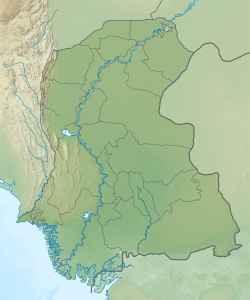Talti | |
|---|---|
| Coordinates: 26°31′38″N67°48′42″E / 26.527191°N 67.811658°E [1] | |
| Country | Pakistan |
| Region | Sindh |
| District | Jamshoro |
| Taluka | Sehwan |
| Population (2017) [2] | |
• Total | 6,716 |
| Time zone | UTC+5 (PST) |
| • Summer (DST) | UTC+6 (PDT) |
Talti is a town and union council [3] in Sehwan taluka of Jamshoro District, Sindh, Pakistan. [4] [5] It is located in the historical pargana of Baghban, [6] 8 miles north of Sehwan and 2 miles off the main road from Sehwan to Larkano. [4] It also has road connections with nearby Bhan and Bubak. [4] There is a dhandh near Talti that is used as a source of fishery. [4]
As of 2017, Talti has a population of 6,716, in 1,387 households, [2] while the total population of the Talti union council is 37,694. [3] It is the seat of a tappedar circle, which also includes the villages of Bilawalpur, Duridero Jatoi, and Jatoi. [2]
The Sufi saint Makhdoom Bilawal was born here in 1451. [6] Later, around 1520, Talti was the site of the battle where the Samma dynasty was decisively defeated by Shah Beg Arghun, who as a result of the battle became the uncontested ruler of Sindh. [4] In this battle, the Sammas were joined by Sehta and Sodha tribesmen in an alliance facilitated by Makhdoom Bilawal and other local religious leaders. [7] After the battle, Shah Beg encamped at Talti for three days. [7] He had Talti and its small fort razed, its crops destroyed, and its inhabitants massacred. [7]
Around 1874, Talti was described as a small town with an estimated population of about 900: about 250 were Muslims, mostly Khaskheli, and about 650 were Hindus, mostly Lohanos. [4] It had a small police station, a government vernacular school, and a dharamsala. [4] There was no significant industry in the town at the time apart from small-scale production of cloth and rugs. [4] Local trade consisted of ghee, grain, and oil, but there was no major long-distance trade. [4]
Less than 1km east of Talti, by the road to Bubak, is the 18th-century dargah of the Muslim holy man Shahab Uddin Shah Bukhari. [8] The tomb is well-maintained by the locals and was significantly renovated in the 2000s or 10s, and new āina-kāri decoration was also added at the same time. [8]
The 1951 census recorded the village of Talti as having an estimated population of about 690, in about 350 houses. [9] It had a Sanitary Committee at that point. [9]

